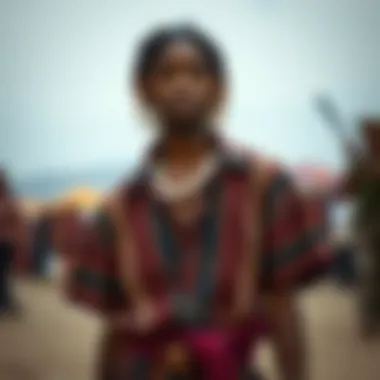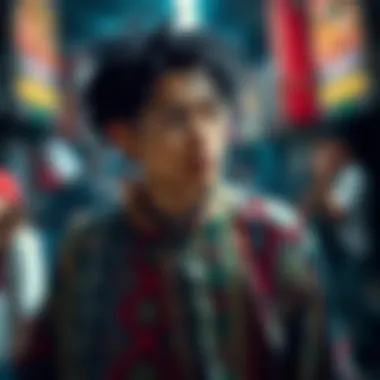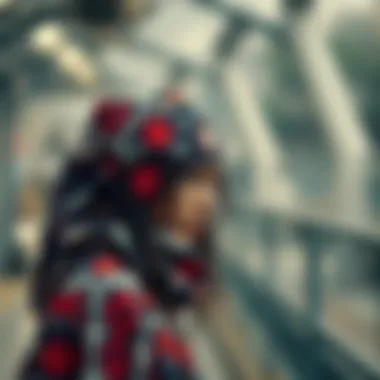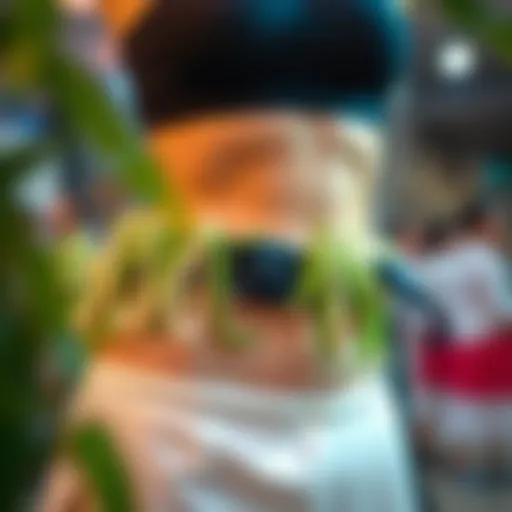Exploring the Depths of Tribal Print Clothing


Intro
Tribal print clothing serves not just as a fashion statement but as a vibrant tapestry woven with the threads of culture, history, and identity. With origins deeply rooted in various indigenous communities worldwide, these prints embody stories, heritage, and artistry. As the fashion landscape evolves, the contours of tribal print clothing have witnessed a compelling transformation, adapting to the contemporary aesthetic while retaining their profound significance.
This article will take you on a journey through the intricate world of tribal prints, starting from their cultural significance to their place in modern wardrobes. We'll explore how these patterns have managed to captivate diverse audiences and their implications on personal expression. Furthermore, we’ll delve into the intersection of fashion and sustainability, providing insights that resonate with today’s eco-conscious consumers.
Fashion Trends
As we navigate the currents of modern fashion, tribal prints emerge as a key player, intricately linked to cultural narratives and artistic expression. This section highlights current seasonal trends and influential figures, showcasing how tribal patterns are reimagined and celebrated in contemporary styles.
Current Seasonal Trends
In recent catwalks, tribal prints have made a bold statement, harmonizing with seasonal colors and textures. Expect to see vibrant hues inspired by nature and earthy tones that reflect the spirit of tribal artistry. For the fall/winter collection, rich browns and warm reds paired with geometric tribal motifs create a striking visual appeal.
- Patterns to Watch: Look for Afrofuturistic designs and Aztec-inspired prints that add a fresh twist.
- Materials: Natural fabrics like cotton and linen are making a comeback, with many designers opting for eco-friendly dyes to align with sustainable choices.
Influential Fashion Icons
Several fashion icons have embraced tribal prints and ingeniously integrated them into their signature styles. Think of renowned designers like Roksanda Ilincic and Etro, who effortlessly blend traditional tribal elements with modern silhouettes. These visionaries challenge fashion norms and inspire budding stylists to explore the depth of tribal motifs.
"The voice of tribal print transcends mere clothing; it is a dialogue between the past and the present, a celebration of heritage in the fabric of our daily lives."
Styling Tips
To incorporate tribal print clothing into your repertoire, understand that these garments carry weight in both style and statement. Below are critical tips to consider:
Outfits for Different Occasions
- Casual Outings: Pair a tribal print t-shirt with neutral chinos or denim for a relaxed look. Comfy yet stylish.
- Formal Events: A tribal print wrap dress can elevate your evening wear, providing a vibrant contrast to classic pieces.
- Work Attire: Integrate a tribal print scarf or bag into your office outfit; it adds character without overwhelming professionalism.
Mix and Match Techniques
- Pair with Solids: Keep base items simple and solid-toned to let the tribal prints stand out without clashing.
- Layering: Combine different textures like denim jackets over tribal print dresses or skirts to create a balanced look.
Preamble to Tribal Print Clothing
Tribal print clothing stands as a testament to the rich tapestry of human culture and expression. In today's fashion landscape, these prints do not merely serve an aesthetic purpose; they carry a deeper significance that delves into identity, heritage, and representation. For designers, stylists, and educators, understanding the importance of tribal prints means recognizing their cultural roots and the stories woven into their very fabric.
Fashion today is increasingly about individuality and connection to one’s heritage. Tribal prints offer a window into this phenomenon, serving as a bridge between the past and the modern world. They embody the customs and traditions of various cultures, making them an integral part of contemporary style narratives. The significance of tribal prints extends beyond mere trends; it's about honoring the artistry and craftsmanship that has been passed down through generations.
When we talk about tribal prints, it’s not just about patterns that look good; it’s about knowing the message behind those patterns. This article will dissect this topic into several sections, exploring the origins, various types of tribal prints, and their evolution in fashion today. In this deep dive, readers will learn how to incorporate these designs into their wardrobes while respecting their cultural implications.
Defining Tribal Prints
Tribal prints, at their core, are patterns that draw inspiration from the distinctive styles of indigenous cultures around the world. These prints often feature geometric shapes, vibrant colors, and symbolic motifs that have great cultural resonance. Each design tells a story, reflecting the history, beliefs, and values of a community. For instance, a fabric pattern might showcase animals or natural elements that are significant in a tribe’s mythology or daily life.
Notably, tribal prints are not homogenous. They can differ dramatically from one region to another, each variation speaking to its own specific cultural narrative. For instance, the intricate and bold designs found in African textiles starkly contrast with the more nuanced motifs seen in Native American designs. Understanding these differences is crucial for anyone engaging with or designing tribal print clothing.
Historical Context
The roots of tribal print clothing stretch back centuries, often tied to ceremonies, rituals, and the everyday lives of the wearers. Many of these patterns originate from ancient tribes that developed textile techniques using handmade materials. Take the Maasai of East Africa, for example, who use bright plaid patterns rich in symbolism to represent their status within the community. Each piece of clothing is not just functional; it’s an important cultural artifact.
As economies changed and global interactions increased, tribal prints began to adapt. During the colonial period, many of these designs were appropriated and commercialized, leading to a complex relationship between indigenous artisans and the fashion industry. The commodification of tribal print clothing has often obscured the original meanings behind these patterns, leading to discussions about authenticity and cultural appreciation versus appropriation. Today, there is a push toward revitalizing these traditional patterns within ethical frameworks, allowing for a revival that honors their original significance.
In summary, tribal prints embody a rich history that goes beyond trends. They reflect the complex interplay between culture, artistry, and commerce. This section has provided a foundation for understanding the importance of tribal print clothing, setting the stage for deeper exploration into their cultural significance and modern adaptation in fashion.
Cultural Significance of Tribal Prints
Tribal prints hold a unique place in the world of fashion, signaling not just aesthetic choices but also deep-rooted cultural narratives. These patterns are more than mere designs; they encapsulate the stories, beliefs, and identities of communities worldwide. Understanding the cultural significance of tribal prints allows fashion designers, bloggers, and retail spaces to create clothing that respects the origins while engaging modern trends.
Understanding the Origins
The origins of tribal prints can be traced back centuries, often tied to specific ethnic traditions and practices. For instance, the bold and vibrant patterns found in African tribal clothing are symbolic of social status, community affiliation, or even personal achievement. Each design narrates a tale of lineage or local folklore, intertwining history and contemporary art.
- African Patterns: Many tribes use specific symbols that are rich in meaning. For example, Adinkra symbols from Ghana convey philosophical ideas, while Zulu beadwork communicates messages through color and design.
- Native American Designs: Similarly, Native American patterns vary from tribe to tribe, each with unique significance. For instance, Navajo textiles often depict the natural world, reflecting their deep connection to earth and spirituality.
Incorporating these designs into fashion requires sensitivity and understanding. It’s essential to dive into the stories behind these prints to avoid cultural appropriation and instead celebrate the artisans who bring them to life. Fashion should not only draw inspiration from these rich backgrounds but should also reflect respect for their cultural roots.
Symbolism in Patterns
The layers of symbolism found in tribal prints are noteworthy.


- Representational Imagery: Various motifs represent local flora and fauna, spiritual beliefs, or social messages. For instance, a spiral pattern in some cultures might symbolize the journey of life, indicating growth or change.
- Colors and Materials: Additionally, the choice of colors often goes beyond aesthetics. Specific hues can represent specific meanings; red might signify love or war, while blue often stands for peace or healing. The materials used also speak volumes—be it dyes sourced from nature or textiles that tell a story through their very fabric.
"Tribal patterns are like a visual lexicon, each line and color tells a story that connects us to cultures far and wide."
By appreciating these details, designers and enthusiasts alike can better respect these cultural symbols while integrating them into modern wearables. It becomes a collaborative dialogue, where the past meets the present, ensuring that the legacies etched into these patterns are honored, not lost amid commercial exploitation.
Types of Tribal Prints
Exploring the varied types of tribal prints serves as a lens into the rich tapestry of cultural traditions and values embodied in fashion. From the vibrant colors of African designs to the profound stories told through Native American patterns, each print carries a significance that transcends mere aesthetics. Recognizing and understanding these distinctions is pivotal for designers and fashion enthusiasts alike, as it informs not only the creation of garments but also the appreciation of heritage.
- Preservation of Culture: Tribal prints shed light on the intricate histories of their respective communities. They breathe life into age-old customs, weaving traditions into the modern fabric of society.
- Fashion Awareness: Awareness of various tribal prints encourages respectful and intentional choices that honor their origins. This knowledge helps avoid cultural appropriation, ensuring that designs are celebrated rather than commodified.
- Creative Inspiration: Designers often draw inspiration from these prints, allowing them to infuse contemporary styles with a sense of depth and history. By integrating these elements, they create pieces that resonate with authenticity.
With this backdrop, let’s delve deeper into the fascinating specifics of different tribal prints.
African Tribal Patterns
African tribal patterns are a feast for the eyes, reflective of the continent's rich diversity and vibrant cultures. Each pattern tells a story, steeped in tradition, identity, and community. These prints often draw inspiration from nature, spirituality, and social structures.
Patterns such as Kente from Ghana capture the essence of community values and individuality through distinct colors and shapes. This elaborate weaving tradition represents stories of ancestry and is often used during ceremonial occasions. The significance of these designs cannot be overstated; they embody collective memory and a celebration of heritage.
Moreover, Afrofuturism has emerged as a notable trend, contemporary African designers are reimagining these prints, merging traditional motifs with modern elements. From bold geometric shapes to intricate lines, they speak to a narrative of progress and hope while still honoring tradition. Today, fashion shows increasingly highlight African prints, propelling them onto global runways.
Native American Designs
Native American designs offer a profound blend of artistry, spirituality, and historical importance. These prints frequently represent the connection between nature and the spirit world, capturing the relationship that Indigenous peoples have with their environments.
Common patterns can be seen in textiles such as Navajo rugs or Pueblo pottery, where nature’s colors—earthy tones, vibrant blues, and rich reds—are predominant. Each design reflects the specific tribe's culture, beliefs, and storytelling methods. For instance, the intricate weaving of the Navajo blanket honors both artistry and historical significance.
Moreover, Native American designers have been working hard to reclaim their narratives within the fashion industry. They promote authenticity and craftsmanship, ensuring that their cultural legacies remain vibrant in contemporary fashion. This resurgence of interest in Native American designs showcases a blend of traditional artistry and modern interpretations, creating pieces that are both meaningful and stylish.
Pacific Island Influences
Pacific Island influences introduce a unique perspective on tribal prints, often characterized by lush colors and organic shapes inspired by their natural surroundings. Engaging with these patterns invites a journey through the histories of Polynesian, Micronesian, and Melanesian cultures.
The use of geometric shapes and motifs found in tapa cloth—made from the bark of trees—has significant ancestral ties. These designs often revel in the motifs that represent flora and fauna, symbolizing the importance of nature within Pacific Islander tradition. The prints also serve as a storytelling mechanism, passed down through generations.
In recent years, fashion outlets have begun embracing these influences, incorporating them into beachwear, swimwear, and casual clothing, creating a fusion between traditional and modern styles. Collaborations with Pacific Island designers emphasize sustainability and respect for these unique aesthetic values, ensuring their continuation into the fashion narrative for years to come.
Understanding the diversity in tribal prints enhances our appreciation for both the artistry and the stories behind them. Engaging thoughtfully with these designs allows us to celebrate rather than appropriate the cultures they originate from.
Through informed design choices, fashion can foster respect and appreciation for the intricate patterns that draw on years of cultural evolution. Whether you're a designer, a stylist, or simply a fashion enthusiast, knowing the types of tribal prints can enrich your understanding of the world of fashion.
Incorporating Tribal Prints in Modern Fashion
Incorporating tribal prints into modern fashion is not just about aesthetics; it’s an essential blending of culture, style, and statement. These vibrant patterns invite a dialogue between traditional artistry and contemporary lifestyle, showcasing not only individual flair but also an appreciation for global diversity. In an age where fashion is often criticized for its lack of authenticity, tribal prints offer a refreshing detour, reminding wearers of their roots and the stories behind each design. The bold colors and intricate patterns can serve as a focal point in any outfit, providing a unique element that elevates personal style.
Casual Wear
Casual wear is often seen as the canvas for creative expression, and tribal prints can certainly take center stage. Pairing a bold tribal-print t-shirt with denim shorts or a flowy skirt can create a relaxed yet stylish look. Here are a few ideas on how to make tribal patterns pop in your casual outfits:
- Layer It Up: A tribal print scarf can easily liven up a simple outfit. Throw it over a monochrome ensemble to add depth.
- Mix and Match: Don't shy away from pairing different tribal patterns. When done tastefully, contrasts can create striking visuals. Imagine a zigzag echoing the curves of traditional African designs.
- Accessory Highlight: Consider tribal-print sneakers or bags. They allow for easy incorporation of the style without overwhelming the outfit.
In casual wear, the goal is to remain comfortable while expressing personality. As various cultures influence popular designs, it becomes even more vital to wear these prints with respect, especially when their heritage runs deep.
Formal Attire
Transitioning tribal elements into formal attire requires a more refined approach but can result in incredibly impactful statements. Fabrics like silk or chiffon with subtle tribal prints can work wonders for evening wear. Some approaches to consider include:
- Tailored Pieces: A well-fitted blazer featuring a subtle tribal motif paired with sleek trousers can command attention at a business meeting or event.
- Statement Dresses: Look for floor-length gowns adorned with tribal patterns. Such pieces may carry the history of their design, giving an aura of sophistication while telling a story.
- Jewelry as an Extension: Integrating tribal-inspired jewelry with formal wear can enhance the outfit’s overall appeal. Think earrings or necklaces that highlight traditional craftsmanship.
Using tribal prints in formal contexts affirms their versatility and elevates conventional fashion norms. The aim should always be to respect the origin of the patterns, ensuring that they don't just serve as a trend but rather as a celebration of artistry from around the world.
"Fashion is about wearing what represents you; tribal prints resonate with cultures, making them more than just cloth."
By incorporating these prints into various outfit types, you celebrate not just the aesthetic aspect of fashion but also its ability to connect us with distant cultures. Select pieces mindfully and wear them with pride, as tribal prints are not merely styles; they are representations of heritage.
Styling Tips for Tribal Prints
Incorporating tribal prints into your wardrobe isn't just about showcasing vibrant patterns; it's about expressing individuality and respecting cultural nuances. The unique designs found in tribal print clothing offer a kaleidoscope of colors and shapes, which allows for endless versatility. Whether you're attending a formal event or dressing for a casual day out, understanding how to style these prints can elevate your overall look, ensuring you stand out for all the right reasons.
Each choice you make when combining tribal prints with other elements can reflect your personal style while paying homage to the intricate historical backgrounds of these patterns. Here are essential insights to consider when styling tribal prints.
Color Pairing Strategies


Choosing the right colors can make or break an outfit featuring tribal prints. The prints themselves often carry a multitude of colors, which can overwhelm if not paired thoughtfully. Here are some effective strategies for pairing colors:
- Neutrals as a Base: When in doubt, go for a neutral palette. Shades like beige, white, or gray can serve as a sleek backdrop that allows the tribal patterns to shine without competing for attention.
- Complementary Colors: Selecting colors on the color wheel that enhance the print can create a harmonious look. For example, if you're wearing bold reds and blacks in the tribal pattern, consider pairing with shades of green, which can make the print pop while remaining visually appealing.
- Monochromatic Schemes: Working within a single color family can lead to a sophisticated aesthetic. For instance, various shades of blue can blend beautifully, allowing the intricacies of the tribal design to take center stage while maintaining cohesiveness.
- Contrasting Accents: Don't shy away from bold contrasts. A bright yellow with earth-toned tribal prints can add a playful vibe—just ensure that it doesn't evoke a clash.
Consider these pairings not only for clothing but also for footwear and bags. This is where you can infuse personal flair without losing the essence of the tribal prints.
Accessorizing Tribal Pieces
Accessories are like the finishing touch that can transform your overall style. When it comes to tribal prints, the right accessories can amplify the cultural story woven into the fabric. Here’s how to accessorize effectively:
- Natural Materials: Opt for accessories crafted from natural fibers or materials to resonate with the organic essence of tribal prints. For example, wooden bangles or woven bags align with the handcrafted quality that many tribal designs embody.
- Layering: Consider layering your accessories for dimension. Combining long necklaces with some chunky tribal earrings can create a rich look that embodies bohemian chic.
- Color Coordination: Just like with clothing, think about color. If your tribal print features hints of orange and blue, try to find accessories that echo these tones. But keep it interesting; mixing a patterned scarf with solid colors can add depth without overwhelming your outfit.
- Statement Pieces: A standout belt or a pair of shoes can serve as an excellent way to ground a heavy print. For instance, a bold pair of ankle boots can bring an edgy feel to softer tribal pieces.
Remember: Accessories should enhance and not overshadow the tribal print. Keep this philosophy in mind when curating pieces for your outfit.
By employing these styling tips, you can harmoniously blend tribal prints into your wardrobe while capturing the essence of their cultural significance. Whether for personal expression or as a nod to heritage, the right approach can turn a simple tribal print garment into a statement that reflects both style and substance.
Fashion Industry and Tribal Prints
The interplay between the fashion industry and tribal prints is intricate and evolving. As cultural narratives gain prominence, tribal prints are no longer relegated to niche markets; they are becoming a significant voice in mainstream fashion. Understanding this connection aids designers, stylists, and retailers to harness the richness of these patterns while upholding their cultural integrity.
Trends in Apparel Design
In the apparel design sector, there is a notable resurgence of tribal prints, influenced by a growing appreciation for authenticity and diversity. Designers are blending traditional motifs with contemporary styles, creating pieces that resonate with both heritage and modernity.
Some trends include:
- Mixing Patterns: Designers are starting to juxtapose tribal prints with other patterns, creating a visual dialogue that tells a story of cultural fusion.
- Sustainable Sourcing: As environmental consciousness rises, many brands are opting for sustainably sourced materials that honor the original artisanship, breathing new life into designs while reducing ecological impact.
- Customizable Fashion: Customization is increasingly popular. Small businesses and independent designers are allowing customers to personalize tribal prints, making them more relevant to individual expression.
These trends are vital not only in terms of sales but also for sparking conversations surrounding the importance of preserving cultural narratives.
Crossover with Street Fashion
The connection between tribal prints and street fashion is growing deeper, appealing to a younger audience that values both style and substance. Street fashion often serves as a canvas for self-expression, and tribal patterns provide a rich vocabulary for this expression. Attributes of this crossover include:
- Bold Statements: Streetwear is all about making a statement, and tribal prints do just that. The vibrant colors and intricate designs speak volumes, catching the eye in any urban landscape.
- Collaborative Designs: Collaborations between high-fashion brands and streetwear influencers are on the rise. These partnerships often take inspiration from tribal aesthetics, further blurring the lines between traditional prints and contemporary culture.
- Everyday Wear: Styles incorporating tribal prints have seeped into casual wear, with items like oversized hoodies or joggers featuring these designs, making them accessible for day-to-day fashion without losing their cultural essence.
The merging of traditional tribal elements with street fashion allows for a dynamic space where cultural appreciation meets individual expression, fostering a rich tapestry of diversity in the fashion landscape.
This evolution in the fashion industry demonstrates that tribal prints carry profound significance that extends beyond mere aesthetics. By embracing these prints, designers and consumers alike can engage with a more meaningful narrative that appreciates and respects the origins of the art form.
Sustainability and Ethical Considerations
In the realm of fashion, the issue of sustainability and ethics has become a hot topic, particularly when discussing tribal print clothing. This focus is not merely a trend. It's about understanding the broader impact of clothing choices on cultures and the environment. As we dive into tribal prints, it becomes essential to consider how sustainable practices can facilitate respect for the traditions and artistry behind these unique designs.
Sustainable Fabric Choices
When it comes to tribal print clothing, the fabrics used play a crucial role in determining its sustainability. Fabric choices that are eco-friendly not only reduce the environmental impact but also support local economies and artisan communities. Here are some of the key sustainable fabric options:
- Organic Cotton: Grown without pesticides, organic cotton is a sustainable alternative that ensures healthy soil and water practices. It brings a soft touch to tribal prints and is often seen in clothing manufactured by ethical brands.
- Linen: This fabric is made from the flax plant, which requires less water than conventional cotton. Linen is naturally biodegradable, making it a great option for eco-conscious consumers.
- Bamboo: Fast-growing and requiring minimal resources to cultivate, bamboo fabric can be an ideal choice. However, the manufacturing process must be scrutinized to ensure it remains environmentally friendly.
- Recycled Fabrics: Utilizing recycled materials reduces waste and the need for virgin materials. Brands focusing on upcycling are often at the forefront of modern ethical fashion.
The benefits of choosing sustainable fabrics extend beyond mere aesthetics. They encompass a commitment to environmental care and social responsibility. Fashion designers and retailers must prioritize sourcing such materials to honor the intrinsic values displayed in tribal patterns.
Supporting Ethical Artisans
Supporting artisans is another vital aspect when discussing sustainability in tribal print clothing. Many of these prints stem from indigenous cultures where craftsmanship is not just a skill but a tradition passed down through generations. Here’s why this support is crucial:
- Fair Payment: Ethical trade practices ensure that artisans receive fair compensation for their labor. This not only uplifts communities but also fosters respect for cultural heritage.
- Preservation of Techniques: Traditional crafting methods are at risk of disappearing in the face of mass production. By backing ethical artisans, we help preserve these techniques, allowing for the transmission of cultural narratives through fashion.
- Empowerment and Education: Supporting artisans often includes efforts to provide education and resources, empowering them to improve their livelihoods without sacrificing their heritage.
Artisanship infuses vitality into tribal prints, rendering them not just clothing items but powerful statements of identity and culture. By prioritizing ethical considerations in fashion, consumers can wear their values proudly. As we curate our wardrobes, it is vital to reflect on how these choices resonate beyond personal style, impacting communities globally.
"Fashion is a part of the daily air and it changes all the time, with all the events. You can even see the approaching of a revolution in clothes. You can see and feel everything in clothes." - Diana Vreeland
Adopting sustainable practices and supporting artisans doesn't just influence the fashion landscape; it helps in crafting a better future for both creators and consumers alike. Ultimately, it's about establishing a foundation of respect, understanding, and appreciation for the rich tapestry woven by tribal print clothing.
Psychology of Tribal Patterns
Understanding the psychology behind tribal patterns provides valuable insights into how these designs affect not only fashion choices but also personal identity. Tribal prints aren't just fabric designs; they carry weighty meanings and resonate with history, culture, and self-expression. By delving into these patterns' psychological implications, we can appreciate their deeper significance in contemporary wardrobes and their role in shaping individual perception.
Impact on Personal Identity
The connection between tribal prints and personal identity is profound. When someone wears clothing adorned with tribal patterns, they often express a part of themselves that might be connected to heritage, ancestry, or a desire to show solidarity with specific cultural narratives.
Indeed, tribal prints serve as a social signal—a way to communicate belonging or appreciation for particular traditions.
- Cultural Heritage: Wearing items with meaningful motifs connects individuals to their roots, especially for those residing far from their places of origin. This sense of identity can also serve a dual role, allowing them to navigate multiple cultural spaces.
- Personal Expression: For others, these fabrics may not indicate a specific ethnic affiliation but reflect a broader appreciation for cultural art. Wearing these prints can express styles that resonate on an aesthetic level more than a cultural one.


When individuals select clothing that features these markings, they engage in a personal narrative that enriches their identity. Items may vary widely, from indigenous Australian prints to African motifs, but each pattern serves as a repository of stories, histories, and personal significance—a narrative wrapped around their very essence.
Cultural Resonance in Fashion Choices
In addition to individual identity, tribal patterns have a broader cultural resonance in the realm of fashion, shaping choices and preferences among diverse communities. These patterns draw attention to the idea that fashion moves beyond transient trends; it can be a reflection of personal and collective histories.
- Cultural Appreciation vs. Cultural Appropriation: A fine line exists in the use of tribal patterns within mainstream fashion. It's crucial for designers and consumers alike to distinguish between appreciation of cultural motifs and appropriating them without acknowledgment. Understanding this informs responsible fashion choices that celebrate heritage instead of commodifying it.
- Diversity in Representation: In many ways, tribal prints celebrate diversity. Designers such as Mara Hoffman or Rag & Bone have embraced the allure of tribal aesthetics while honoring the sources. This brings to the forefront conversations about representation and our collective responsibility to uphold cultural narratives responsibly.
"Fashion is the armor to survive the reality of everyday life." – Bill Cunningham
This quote resonates throughout our discussion on tribal prints, as they can become an armor reflecting history, culture, and personal stories.
By understanding the psychological implications behind tribal patterns, the fashion community can promote informed choices, respecting the rich tapestries these prints represent in the broader cultural landscape.
Global Influence of Tribal Prints
Tribal prints extend far beyond their origins, weaving through various cultures and influencing global fashion. This section delves into the profound impact that tribal designs have made across borders, exploring how they adapt to new environments while retaining their core essence. The integration of these patterns into diverse wardrobes not only celebrates their rich histories but also fosters a deeper understanding and appreciation of cultural intersections.
Cross-Cultural Adaptations
The journey of tribal prints from their roots to mainstream fashion showcases a tapestry of cross-cultural adaptations. In essence, these designs are chameleons, morphing to fit the aesthetics and preferences of different cultures. For instance, African mud cloth, traditionally made by the Bamana people of Mali, has found its way into high fashion, morphing into contemporary jackets and handbags in urban clothing lines.
Key Observations:
- Cultural Fusion: Designers often blend traditional tribal motifs with contemporary cuts. This fusion not only attracts a wider audience but also creates a new narrative around tribal prints.
- Textile Innovation: The use of modern printing technology allows for bright colors and patterns to emerge, enhancing the traditional designs.
- Local Versus Global: While some designers capture the authenticity of tribal prints, others might commercialize them for profit without understanding the cultural significance. This results in a fine line between admiration and appropriation.
"In fashion, adaptation often walks a fine line between inspiration and imitation. Recognizing the heritage behind tribal prints is essential for respectful adaptation."
Tribal Influences Across Continents
The influence of tribal prints can be traced across continents, illustrating humanity's interconnectedness through artistic expression. From North America to Asia, tribal patterns echo shared themes of community, spirituality, and nature.
- North America: Native American designs, characterized by their geometric patterns, have been embraced in modern streetwear. Brands incorporate them into essential tees and sweatshirts, depicting colorful and meaningful stories. This appropriation raises awareness of Native American cultures, yet also invites debate about representation and ownership.
- Europe: European designers, like Vivienne Westwood, draw inspiration from African and Indigenous prints, oftentimes merging historical references with avant-garde methodologies to showcase the depth of these cultures.
- Asia: In countries like Indonesia, batik designs celebrate local traditions while catering to a global market. Collaborations between local artisans and contemporary fashion houses emphasize sustainable practices, promoting both cultural heritage and environmental responsibility.
Through these adaptations, tribal prints do more than just dress; they tell stories that transcend geographic boundaries. They invite conversations about identity, belonging, and the ever-evolving nature of fashion.
Future of Tribal Print Clothing
The conversation around the future of tribal print clothing is not just an academic exercise but a vital exploration of how these cultural garments can thrive in an ever-shifting fashion landscape. With increasing globalization, tribal prints are being reinterpreted and, in some cases, diluted. Yet, there exists a rich opportunity to embrace authenticity and innovation. For designers, staying true to the origins while pushing creative boundaries becomes a fine line to tread.
Emerging Trends and Adaptations
As fashion evolves, so do the trends surrounding tribal prints. Several key aspects stand out when discussing the future of this apparel:
- Diversified Materials: Designers are moving away from standard textiles and venturing into sustainable fabrics. Materials like organic cotton and recycled polyester are gaining traction, reflecting an environmental consciousness that is becoming a priority for many consumers. This paradigm shift aligns with growing demands for ethical fashion while retaining the cultural depth of tribal patterns.
- Digital Influences: The rise of digital fashion and virtual reality allows for unprecedented adaptations of tribal prints. This technology allows designers to create and visualize unique patterns without the constraints of traditional methods. Collaborations between tech and fashion companies are spawning designs that were previously unimaginable. For instance, Augmented Reality could let consumers try on tribal print clothing virtually before making a purchase, merging liability with style.
- Inclusivity: As discussions around diversity intensify, the quest for representation in the fashion industry is on. Tribal prints, often tied to marginalized communities, must reflect voices and stories within their design processes. Future collections might prominently feature collaborations with indigenous artists, being more than mere aesthetics but a vessel for narrative and cultural exchange.
“Fashion is not just about looking good; it’s about what your clothing represents and the stories it tells.” This encapsulates the ambition needed to shift tribal print clothing forward, focusing on storytelling rather than just sales.
Revitalizing Traditional Practices
Revisiting and revitalizing traditional practices is pivotal for the future of tribal prints. The integration of these time-honored techniques into modern manufacturing can yield stunning results:
- Cultural Workshops: Some fashion brands are hosting workshops in tribal communities to share and preserve ancient techniques like hand-weaving and dyeing. This not only empowers local artisans but also enhances the authenticity of the prints featured in contemporary collections.
- Storytelling through Fashion: Every tribal print tells a story. As consumers grow more conscious of the origins of their clothing, brands that highlight these narratives may find themselves at an advantage. Understanding the significance of patterns fosters a greater appreciation among wearers, transforming fashion items into conversations starters.
- Community Engagement: Collaborations with community-led initiatives not only support local economies but also nurture reciprocal relationships. Brands that support artisans with fair wages and transparency in sourcing can cultivate a loyal customer base that values ethical practices.
Epilogue
The journey through tribal print clothing has unveiled an intricate tapestry of cultural significance, modern relevance, and psychological impact. To conclude, it's vital to emphasize the importance of recognizing the diversity of these prints. Approaching tribal prints with open eyes allows for a deeper understanding of their backgrounds. Each design is more than just fabric; it carries stories of heritage, community, and the essence of identities ranging from African tribes to Native American cultures.
In modern fashion, tribal prints are more than just trends—they symbolize a connection to one's roots while blending seamlessly into contemporary wardrobes. Recognizing this can enhance appreciation for craftsmanship. It engages consumers with a genuine curiosity about the artistry behind these patterns. As fashion increasingly integrates these rich prints, it pushes the narrative of sustainability and ethical practices forward.
"Fashion is an expression of the times, and tribal prints remind us of the journey we have taken to arrive at this moment."
Moreover, understanding the psychological resonance of wearing tribal prints is essential. It's more than aesthetics; it's about identity and self-expression. For many, these pieces evoke a sense of pride and belonging, transporting wearers to the cultural spaces they admire and represent. This psychological element becomes crucial, especially for designers and retailers, as it offers insight into consumer behavior.
Ultimately, the appreciation of tribal prints fosters informed choices among consumers. It encourages them to not only wear these vibrant designs but also to respect their origins. This respect leads to meaningful dialogue within the fashion community, bridging the gap between tradition and the ever-evolving landscape of style.
Appreciating the Diversity of Tribal Prints
Diversity in tribal prints illustrates the vast array of cultures from which they emerge. Each print is meticulously crafted, reflecting the unique values and narratives of the communities behind them. From the intricate geometric designs found in African textile patterns to the meaningful icons cherished in Native American crafts, the importance of this diversity cannot be overstated.
When exploring tribal prints, one should consider several poignant factors that amplify their appreciation:
- Cultural Roots: Each print carries with it the traditions and histories that shaped it. Understanding these roots offers a fresh perspective, transforming the way we approach fashion.
- Variability in Patterns: The variation in designs is astonishing. No two prints are identical, and the patterns can signify different meanings based on region and community.
- Artisan Techniques: Many tribal prints are created using time-honored methods that take years to master. Supporting these artists not only helps preserve cultural heritage but also empowers local economies.
Encouragement for Informed Fashion Choices
As the lines between fashion and ethics blur, making informed choices is becoming increasingly critical. Consumers must consider the origins of the clothing they wear, particularly with tribal prints. Here’s how one can be more discerning:
- Research Brands: Investigate the brands you support. Do they promote ethical practices and collaborate directly with the communities whose prints they use? Transparency is key.
- Choose Sustainable Fabrics: Look for companies that prioritize sustainable fabric options. This not only benefits the environment but also supports artisans who strive to maintain traditional techniques.
- Engage with Culture: When wearing tribal prints, approach them with respect. Understand the stories and significance behind what you are wearing. Sharing this knowledge serves to further educate others, expanding the appreciation of these stunning designs.
In summation, acknowledging the complexity and richness of tribal print clothing fosters a more responsible fashion industry. Whether you are a designer, a retailer, or a shopper, every choice made can contribute to a greater understanding and respect for the cultural narratives woven into every garment.















